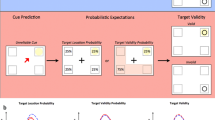Abstract
We recently introduced an accurate and countermeasure resistant P300-based deception detection test called the complex trial protocol (Rosenfeld et al. in Psychophysiology 45(6):906–919, 2008). When subjects use countermeasures to all irrelevant items in the test, the probe P300 is increased rather than reduced (as it was in previous P300-based deception protocols), allowing detection of countermeasure users. The current experiment examines the role of task demand on the complex trial protocol by forcing the subject to make countermeasure-like response to stimuli. Subjects made either a simple random button response to both probe and irrelevant stimuli (experiment 1) or a more complex, assigned, button response to probe and irrelevant stimuli (experiment 2). We found that an increase in task demand reduced the effectiveness of the test. Using random responses we found a simple guilty hit rate of 11/12 with no false positives, but only a 4/11 hit rate for countermeasure-users. Using assigned responses we found a simple guilty hit rate of 8/15 with no false positives, and a 7/16 hit rate for countermeasure-users. We herein suggest that the high level of task demand associated with these countermeasure-like responses causes reduced hit rates.









Similar content being viewed by others
References
Allen, J., Iacono, W. G., & Danielson, K. D. (1992). The identification of concealed memories using the event-related potential and implicit behavioral measures: A methodology for prediction in the face of individual differences. Psychophysiology, 29, 504–522.
Ben-Shakhar, G. (2002). A Critical Review of the Control Questions Test (CQT). In M. Kleiner (Ed.), Handbook of polygraph testing (pp. 103–126). London: Academic Press.
Donchin, E., & Coles, M. G. H. (1988). Is the P300 component a manifestation of context updating? Behavioral and Brain Sciences, 11, 355–372.
Donchin, E., Kramer, A., & Wickens, C. (1986). Applications of brain event related potentials to problems in engineering psychology. In M. Coles, S. Porges, & E. Donchin (Eds.), Psychophysiology: Systems, processes and applications (pp. 702–710). Guilford: New York.
Fabiani, M., Gratton, G., Karis, D., & Donchin, E. (1987). The definition, identification and reliability of measurement of the P300 component of the event-related brain potential. In P. K. Ackles, J. R. Jennings, & M. G. H. Coles (Eds.), Advances in psychophysiology (Vol. 2, pp. 1–78). Greenwich, CT: JAI Press.
Farwell, L. A., & Donchin, E. (1991). The truth will out: Interrogative polygraphy (“lie detection”) with event-related potentials. Psychophysiology, 28, 531–547.
Grier, J. B. (1971). Non-parametric indexes for sensitivity and bias: Computing formulas. Psychological Bulletin, 75, 424–429.
Gronau, N., Ben-Shakhar, G., & Cohen, A. (2005). Behavioral and physiological measures in the detection of concealed information. Journal of Applied Psychology, 90, 147–158.
Johnson, R. (1988). The amplitude of the P300 component of the event-related potential: Review and synthesis. In P. Ackles, J. R. Jennings, & M. G. H. Coles (Eds.), Advances in psychophysiology: A research annual (Vol. 3, pp. 69–137). Greenwich, CT: JAI Press, Inc.
Lykken, D. T. (1959). The GSR in the detection of guilt. Journal of Applied Psychology, 43, 385–388.
Lykken, D. T. (1960). The validity of the guilty knowledge technique: The effects of faking. Journal of Applied Psychology, 44, 258–262.
Lykken, D. T. (1981). A tremor in the blood. Reading, Mass: Perseus Books.
Meijer, E. H., Smulders, F. T. Y., Merckelbach, H. L. G. J., & Wolf, A. G. (2007). The P300 is sensitive to face recognition. International Journal of Psychophysiology, 66(3), 231–237.
Meixner, J. B., & Rosenfeld, J. P. (2009). Countermeasure mechanisms in a P300-based concealed information test. Psychophysiology (in press).
Mertens, R., & Allen, J. B. (2008). The role of psychophysiology in forensic assessments: Deception detection, ERPs, and virtual mock crime scenarios. Psychophysiology, 45(2), 286–298.
Rosenfeld, J. P., Cantwell, G., Nasman, V. T., Wojdac, V., Ivanov, S., & Mazzeri, L. (1988). A modified, event-related potential-based guilty knowledge test. International Journal of Neuroscience, 24, 157–161.
Rosenfeld, J. P, & Labkovsky, E. (2009). Updated P300-based complex trial protocol to detect concealed information: Resistance to mental countermeasures against only half the irrelevant stimuli. Psychophysiology (submitted).
Rosenfeld, J. P., Labkovsky, E., Lui, M. A., Winograd, M., Vandenboom, C., & Chedid, K. (2008). The Complex Trial Protocol (CTP): A new, countermeasure-resistant, accurate P300-based method for detection of concealed information. Psychophysiology, 45(6), 906–919.
Rosenfeld, J. P., Soskins, M., Bosh, G., & Ryan, A. (2004). Simple effective countermeasures to P300-based tests of detection of concealed information. Psychophysiology, 41, 205–219.
Rosenfeld, J. P., Tang, M., Meixner, J. B., Winograd, M., & Labkovsky, E. (2009). The effects of asymmetric versus symmetric probability of targets following probe and irrelevant stimuli in the complex trial protocol (CTP) for detection of concealed information with P300. Physiology and Behavior (in press).
Seymour, T., Seifert, C. M., Shafto, M. G., & Mosmann, A. L. (2000). Using response time measures to assess “guilty knowledge”. Journal of Applied Psychology, 85, 30–37.
Soskins, M., Rosenfeld, J. P., & Niendam, T. (2001). The case for peak-to-peak measurement of P300 recorded at.3 hz high pass filter settings in detection of deception. International Journal of Psychophysiology, 40(17), 3–180.
Sutton, S., Braren, M., Zubin, J., & John, E. R. (1965). Evoked potential correlates of stimulus uncertainty. Science, 150, 1187–1188.
The National Research Council. (2003). The polygraph and lie detection. Washington DC: The National Academies Press.
Wasserman, S., & Bockenholt, U. (1989). Bootstrapping: Applications to psychophysiology. Psychophysiology, 26, 208–221.
Acknowledgments
This research was supported by the Defense Academy for Credibility Assessment DODP198-P-0001 and DoDPI04-P-0002 awarded to J. Peter Rosenfeld.
Author information
Authors and Affiliations
Corresponding author
Rights and permissions
About this article
Cite this article
Meixner, J.B., Haynes, A., Winograd, M.R. et al. Assigned Versus Random, Countermeasure-Like Responses in the P300 Based Complex Trial Protocol for Detection of Deception: Task Demand Effects. Appl Psychophysiol Biofeedback 34, 209–220 (2009). https://doi.org/10.1007/s10484-009-9091-4
Received:
Accepted:
Published:
Issue Date:
DOI: https://doi.org/10.1007/s10484-009-9091-4




